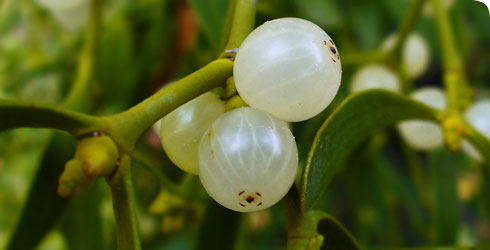Uses
Mistletoe is commonly associated with the druids of ancient Celtic society. According to Roman historians, the druids held mistletoe as a sacred plant, cutting it from oaks with a golden sickle and using it as a medicine and as an aid to fertility.
Despite its poisonous nature, mistletoe has been investigated as a treatment for various conditions, including cancer.
In some countries the sticky viscin is still used as bird lime, with squashed mistletoe berries smeared on twigs to trap birds.
Nowadays, mistletoe is mostly associated with Christmas when large quantities are collected and sold as a decoration, but this use did not appear until the 18th century. The tradition is common throughout the English-speaking world but is largely unknown in the rest of Europe and elsewhere. In North America, species of the related genus Phoradendron is used instead.
To comply with custom, the mistletoe hung up at Christmas should have berries. Each time 2 people kiss beneath it, a berry must be plucked. When all the berries are gone, the privilege ceases. Such kissing was once recognised as a promise to marry, and the presence of the mistletoe is a reflection of its original role in bestowing good luck and fertility on the couple.
